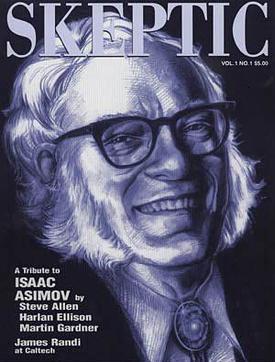
Bigfoot, also commonly referred to as Sasquatch, is a large and hairy human-like mythical creature alleged by some to inhabit forests in North America, particularly in the Pacific Northwest. Bigfoot is featured in both American and Canadian folklore, and has become an enduring icon in popular culture.

The Committee for Skeptical Inquiry (CSI), formerly known as the Committee for the Scientific Investigation of Claims of the Paranormal (CSICOP), is a program within the U.S. non-profit organization Center for Inquiry (CFI), which seeks to "promote scientific inquiry, critical investigation, and the use of reason in examining controversial and extraordinary claims." Paul Kurtz proposed the establishment of CSICOP in 1976 as an independent non-profit organization, to counter what he regarded as an uncritical acceptance of, and support for, paranormal claims by both the media and society in general. Its philosophical position is one of scientific skepticism. CSI's fellows have included notable scientists, Nobel laureates, philosophers, psychologists, educators, and authors. It is headquartered in Amherst, New York.
Skeptical Inquirer is a bimonthly American general-audience magazine published by the Committee for Skeptical Inquiry (CSI) with the subtitle: The Magazine for Science and Reason.

Scientific skepticism or rational skepticism, sometimes referred to as skeptical inquiry, is a position in which one questions the veracity of claims lacking empirical evidence. In practice, the term most commonly refers to the examination of claims and theories that appear to be beyond mainstream science, rather than the routine discussions and challenges among scientists. Scientific skepticism differs from philosophical skepticism, which questions humans' ability to claim any knowledge about the nature of the world and how they perceive it, and the similar but distinct methodological skepticism, which is a systematic process of being skeptical about the truth of one's beliefs.

Michael Brant Shermer is an American science writer, historian of science, executive director of The Skeptics Society, and founding publisher of Skeptic magazine, a publication focused on investigating pseudoscientific and supernatural claims. The author of over a dozen books, Shermer is known for engaging in debates on pseudoscience and religion in which he emphasizes scientific skepticism.

Skeptic, colloquially known as Skeptic magazine, is a quarterly science education and science advocacy magazine published internationally by The Skeptics Society, a nonprofit organization devoted to promoting scientific skepticism and resisting the spread of pseudoscience, superstition, and irrational beliefs. First published in 1992, the magazine had a circulation of over 40,000 subscribers in 2000.

Jon-Erik Beckjord was an American paranormal investigator, photographer, and cryptozoologist interested in UFOs, crop circles, the Loch Ness Monster, and Bigfoot. Throughout his life, he owned three separate, small-scale museums that featured displays, mostly photographs, of alleged UFO, Nessie, and Bigfoot sightings. He made guest appearances on national radio and television shows, but was criticized by skeptics and fellow cryptozoologists alike for not providing substantive evidence to back up his claims of the existence of paranormal beings.

The Amazing Meeting (TAM), stylized as The Amaz!ng Meeting, was an annual conference that focused on science, skepticism, and critical thinking; it was held for twelve years. The conference started in 2003 and was sponsored by the James Randi Educational Foundation (JREF). Perennial speakers included Penn & Teller, Phil Plait, Michael Shermer and James "The Amazing" Randi. Speakers at the four-day conference were selected from a variety of disciplines including scientific educators, magicians, and community activists. Outside the plenary sessions the conference included workshops, additional panel discussions, music and magic performances and live taping of podcasts including The Skeptics' Guide to the Universe. The final Amazing Meeting was held in July 2015.

Benjamin Radford is an American writer, investigator, and skeptic. He has authored, coauthored or contributed to over twenty books and written over a thousand articles and columns on a wide variety of topics including urban legends, unexplained mysteries, the paranormal, critical thinking, mass hysteria, and media literacy. His book, Mysterious New Mexico: Miracles, Magic, and Monsters in the Land of Enchantment, was published in the summer of 2014 and is a scientific investigation of famous legends and folklore in the state of New Mexico. In 2016 Radford published Bad Clowns, a 2017 IPPY bronze award winner, and he is regarded as an expert on the bad clowns phenomenon.

NZ Skeptics is a New Zealand incorporated society created in 1986, with the aim of promoting critical thinking. The main areas of interest to the NZ Skeptics are claims of psychic abilities, alternative medicine, creationism and other pseudoscientific claims. At its founding in 1986, it was known as the New Zealand Committee for the Scientific Investigation of Claims of the Paranormal (NZCSICOP). In 2007 the name was formally changed to NZ Skeptics Incorporated.

Daniel Loxton is a Canadian writer, illustrator, and skeptic. He wrote or co-wrote several books including Tales of Prehistoric Life, a children's science trilogy, and Abominable Science!, a scientific look at cryptozoology. As editor of Junior Skeptic, Loxton writes and illustrates most issues of Junior Skeptic, a children's science section in the Skeptics Society's Skeptic magazine.

The 10:23 Campaign (stylized as 1023) is an awareness and protest campaign against homoeopathy organised by the Merseyside Skeptics Society, a non-profit organisation, to oppose the sale of homoeopathic products in the United Kingdom. The campaign has staged public "overdoses" of homoeopathic preparations.

Desiree Schell is the host of the live Canadian call-in radio talk show and podcast, "Science for the People". An advocate for scientific skepticism, Schell is a strong advocate of critical thinking and is strongly interested in the promotion of skepticism publicly. In her work as a labour organizer Schell creates curricula and teaches courses on effective activism, drawing on the experience of other social movements.

Karen Stollznow is an Australian-American author, linguist, public speaker, and podcaster. Her books include Missed Conceptions: How We Make Sense of Infertility, On the Offensive: Prejudice in Language Past and Present, The Language of Discrimination, God Bless America: Strange and Unusual Religious Beliefs and Practices in the United States, Haunting America, Language Myths, Mysteries and Magic, Hits and Mrs, and Would You Believe It?: Mysterious Tales From People You'd Least Expect. Stollznow also writes short fiction, including the title Fisher's Ghost and Other Stories, and she is a host on the podcast Monster Talk with Blake Smith. She has written for many popular publications, including The Conversation and Psychology Today. Stollznow has also appeared as an expert on many TV shows, including A Current Affair and the History Channel's History's Greatest Mysteries.

SkeptiCamp was founded by Reed Esau in 2007 and is small grassroots conference where scientific skeptics come together and participate and present. Skepticamps are held in varying formats worldwide and are operated in the style of an unconference.

Timothy Patrick Farley is a computer software engineer, writer and instructor who lives in Atlanta, Georgia. He is an expert in computer security and reverse engineering as well as a skeptic. He was a research fellow of the James Randi Educational Foundation. Tim Farley is the creator of the website What's The Harm?, a resource where stories are documented and categorized about the damage done when people fail to use critical thinking skills. Farley was also instrumental in the apprehension of spammer "David Mabus."

Edinburgh Skeptics is a nonprofit organisation that promotes science, reason and critical thinking in Edinburgh and throughout Scotland. It was founded in 2009. The Society hosts regular social and educational events in Edinburgh and has campaigned against the use of homeopathy and challenged claims of ghost sightings.














